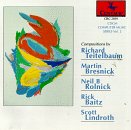| All Artists: Cdcm Computer Music Series, Neil B. Rolnick, Scott Lindroth, Richard Teitelbaum, Rick Baitz, Martin Bresnick Title: CDCM Computer Music Series Vol. 2 -- iEAR Studios, Rensselaer Polytechnic Institute Members Wishing: 2 Total Copies: 0 Label: Centaur Release Date: 11/3/1993 Genres: Dance & Electronic, Classical Styles: Historical Periods, Modern, 20th, & 21st Century Number of Discs: 1 SwapaCD Credits: 1 UPCs: 750582971532, 044747203928 |
Search - Cdcm Computer Music Series, Neil B. Rolnick, Scott Lindroth :: CDCM Computer Music Series Vol. 2 -- iEAR Studios, Rensselaer Polytechnic Institute
CD Details |
CD ReviewsNot one to win converts Steve Benner | Lancaster, UK | 07/24/2001 (2 out of 5 stars) "This second volume in the CDCM Computer Music Series focuses on mid- to late-1980's compositions emanating from the iEAR Studios at Rensselaer Polytechnic Institute, Troy, NY. In particular, it concentrates on works of computer music specifically written for real-time concert performance. Given the date of composition of the pieces, you can assume that that generally means either computer controlled MIDI synthesisers, or else compositions for the Synclavier computer music system. The disc contains five substantial works produced at Rensselaer by different composers - noticeably all men. (tsk! tsk!)The collection opens with Richard Teitelbaum's "Golem I" (1987), for computer music performance system. This work is a musical portrayal of Rabbi Lowe's creation of an artificial man (or Golem) from clay on the banks of the Moldau in Prague in the spring of 1580. It opens with a quiet sonic soup, made of the calls of spring peepers (frogs), over which computer-altered incantations of Hebrew letters as well as verses from the Book of Genesis (in English) are gradually overlaid. These incantations never become particularly distinct, though, for they become obscured by the development of an increasingly powerful series of electronic organ-like chords, which are gradually replaced by a rather soulless and mechanical synthesiser melody. As the incantations die away, the electronic textures start to develop something of life of their own, albeit something of a directionless one, as the rhythms and harmonies become strained, and the work acquires a menacing and rather disconcerting quality. Sadly, rather than being the powerful indictment of modern mechanisation, which I think the work is intended to be, it comes across more as an argument against its own kind, pointing up the potential drawbacks to the employment of computers for the production of music. As a consequence, it does rather work against itself and is not an auspicious start to the disc.Unfortunately, the other works presented here fair no better. Martin Bresnick's "Lady Neil's Dumpe" (1987) for computer and Yamaha TX816 takes its inspiration from "My Lady Careys Dompe", one of the earliest known English keyboard compositions (dating from c. 1525). Bresnick's work starts out emulating a Renaissance dance piece, using synthesised harpsichord. Gradually, other bright and twangy voicings, typical of FM-synthesis modules, enter and an underlying sequencer beat brings in a jazzier, almost pop feel to the work, before it retires once more into its thrashing harpsichord continuo. While the production of this piece may have been an interesting programming exercise, one can't help but wonder about its actual musical worth.Neil B. Rolnick's piece "What is the Use?" (1985) sounds like an improvised study using both pitched and unpitched electronic components. It moves from introspection to exuberance and thence on to downright distress before returning to the plain mischievous and finally reaching just out-and-out bored. The work has its moments, but ultimately the title sums it up."Kaleidocycles" (1985), for Synclavier, by Rick Baitz, builds patterns of sound from gently pulsating tones and percussion sounds, eventually building into a dance-like beat. Unfortunately, the piece remains tonally and musically uninteresting throughout. The same problems plague Scott Lindroth's rather similar work, also for Synclavier, "Syntax" from the same year. While this piece uses a little more variety in its sound world, it offers little to challenge (or even entertain) the listener.In summary, then, this disc is quite a disappointment. With a little more humanity and less intellectuality, perhaps, the works presented here might just have offered something of a wider interest. As they stand, these works are too cold, mechanical and impersonal to warrant repeated listening. The disc may be of interest to serious students of computer music of the late twentieth century, but followers of mainstream 80's and 90's synthesiser music from the likes of Tangerine Dream will probably wonder what all the fuss is about."
|


 Track Listings (8) - Disc #1
Track Listings (8) - Disc #1